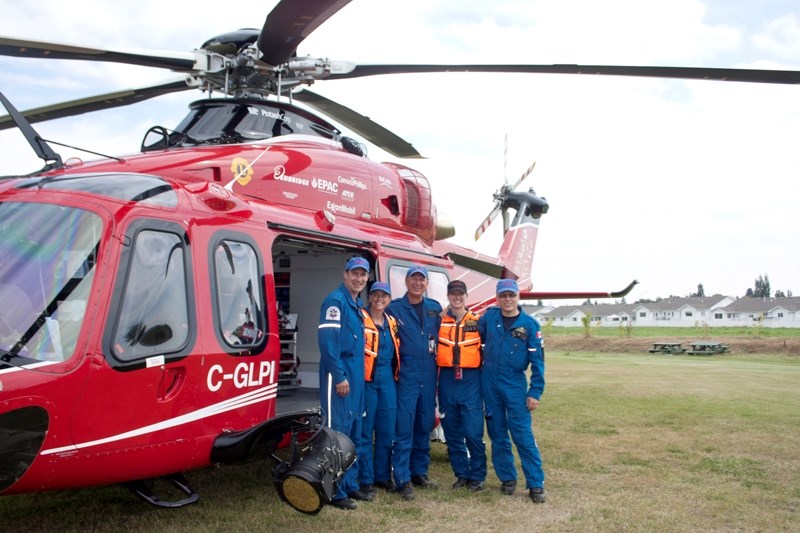Whoop, whoop, whoop, whoop …
Like a giant red insect, its wings beating frenetically, the AW139 helicopter descended from an overcast sky onto a patch of Barrhead grass.
The draft from the blades was so fierce, many observers had to turn around, lower cameras and shield their eyes. Dust, blades of grass and the odd bit of litter were swept up in the whirlwind. Sunglasses were in danger of being torn from faces.
When the air settled as the blades slowly rotated to a stop, and the first person emerged from the cockpit, about 50 people swarmed towards the latest addition to STARS’ fleet of aircraft.
Among them were Barrhead Mayor Brian Schulz, reeve Bill Lee, deputy reeve Bill Lane, several other Town and County councillors, and fire, ambulance and police personnel. Some people who had benefited from STARS also attended to demonstrate their appreciation.
Last Wednesday’s arrival of STARS’ new Edmonton-based AW139 helicopter had created a buzz in more ways than one in Barrhead.
The fact it circled the area several times before landing at 1:45 p.m. – about 30 minutes later than scheduled – only heightened anticipation.
Now on the ground between the fire hall and the RCMP building, the insect had transformed into a gleaming, beautiful machine, the occasional shaft of sunlight bouncing off the cabin door and fuselage.
The dimensions were impressive: 54 feet long, with four 45-foot blades. From the shine of its paintwork, the sleekness of its design, and the large interior fitted with medical equipment, the aircraft exuded state-of-the-art technology.
On the tail were written a list of organizations that had contributed to the $18 million price tag, which includes all the interior fittings. One of the donors was Canada’s 4-H movement, a source of immense pride to Barrhead.
The AW139 came to Barrhead as part of the Shock Trauma Air Rescue Society’s “outreach training” in advance of the aircraft becoming operational, possibly as early as next month. Earlier it had been to Fort Saskatchewan, Waskatenau and Athabasca.
It is scheduled to visit Morinville, Westlock, Tomahawk, Buck Lake, Warburg and Calmar on Friday, Aug. 23.
On board last week were pilots Andre Rioux and Greg Cars, nurses Sherry Brooks and Lori Coutts, and paramedic John Ernst.
A pilot for 25 years, Rioux said the AW139 was a joy to fly. The model had been in existence since 2008, he said, although this particular aircraft was about two years old.
“It is beautiful, smooth and fast,” he said.
Rioux, a STARS veteran of 13 years, said the helicopter could travel at speeds of 260-300 kilometres per hour, depending on the wind.
Normal altitude was about 1,500 feet, although it could fly as high as 10,000 feet, he added.
One of the special features is a de-icing capability, enabling it to fly in tough winter conditions.
“It is definitely a state-of-the-art helicopter,” said Rioux.
He added STARS now had two AW319s – the other one was in Calgary. A third would be coming to Saskatoon.
STARS communications officer Cam Heke said the AW139 had been certified by Transport Canada.
As a result, he said, STARS was intensifying its training schedule to include outreaches to key communities served by the Edmonton base.
“The training is meant to ensure our staff and partners on the ground are well prepared to work safely in and around the new helicopter,” he said.
“We anticipate the AW139 and our crew will be ready to fly missions in September, depending on how quickly we move through training, coupled with aircraft availability and aircraft maintenance.”
The new STARS helicopter has already made its mark in Barrhead.
There was cheering as the AW139 rose above the town, becoming an insect again as it headed towards Nisku, its final stop before returning to Edmonton.
Behind, it left feelings of wonder, gratitude and pride.



